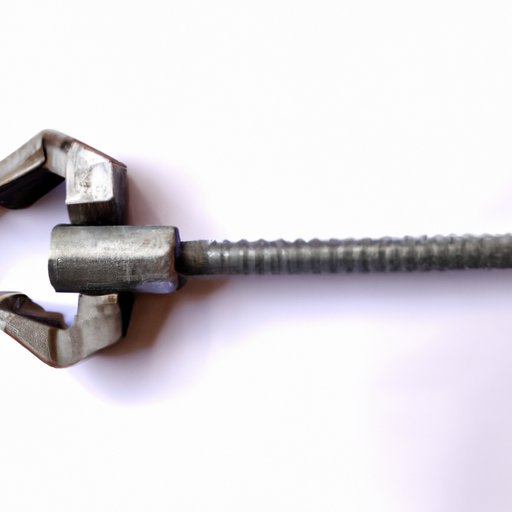
Introduction
Have you ever wondered how bridges and buildings remain standing even when under immense weight and force? One of the main factors that allow structures to maintain their stability is shear stress. Shear stress is a common term used in the field of mechanics and engineering, and it refers to the stress that occurs when an object experiences a force parallel to its surface. In this article, we will discuss the basics of shear stress, its applications, misconceptions, and the importance of understanding its role in engineering.
Defining Shear Stress: An Introduction to Mechanics
In mechanics, stress refers to the internal forces that an object experiences as a result of external forces acting upon it. Shear stress, therefore, occurs when an object experiences a force parallel to its surface. It is important to note that shear stress is not the same as normal stress, which occurs when a force is applied perpendicular to the object’s surface. Rather, shear stress occurs when objects experience a sliding force that causes deformation to the object.
In order to better understand shear stress, it is important to understand the difference between shear force and shear stress. Shear force refers to the external force that acts upon an object, while shear stress refers to the internal resistance to that force. Shear stress is measured in units of force per unit area, typically in pascals or PSI.
Understanding Shear Stress: A Comprehensive Guide
There are a number of factors that can cause shear stress in an object. These include bending, twisting, and cutting or shearing forces. Objects with uneven surfaces or those that are not uniformly shaped are also more susceptible to shear stress. It is important to note, however, that while shear stress can cause deformation or failure in an object, it can also be necessary for certain structures to maintain their stability.
There are several different types of shear stress, including torsional shear, transverse shear, and in-plane shear. Torsional shear occurs when an object is twisted along its axis, while transverse shear occurs when an object experiences a force perpendicular to its length. In-plane shear, on the other hand, occurs when an object experiences a sliding force parallel to its surface.
In order to measure shear stress, engineers use a variety of tools and techniques. These can include computer simulations, physical tests, and mathematical models. By understanding the level of shear stress an object can handle, engineers can determine the appropriate materials and design for a given structure.
The Importance of Shear Stress in Engineering and Construction
Shear stress plays a critical role in the stability and safety of buildings, bridges, and other structures. Engineers must carefully calculate and account for the level of shear stress an object can tolerate before designing and constructing a structure. Failure to do so can lead to disastrous consequences, including the collapse of the structure.
One example of a structure that heavily relies on shear stress for stability is a suspension bridge. Suspension bridges use cables anchored to towers on either side of a body of water to create a support system for the bridge deck. The cables must be strong enough to handle the weight of the bridge deck and the forces of wind and traffic. Because the cables experience a significant amount of shear stress, proper design and construction is critical to the safety of the bridge and those who use it.
Shear Stress in Action: Real-Life Examples and Their Applications
Shear stress plays an important role in a variety of industries and applications. In the field of product design, for example, shear stress is used to evaluate the strength and durability of products. For example, a pair of scissors must be able to withstand the cutting force applied when cutting fabrics or papers.
In the medical field, shear stress is also an important consideration. Bed sores, also known as pressure ulcers, are caused by prolonged pressure and shear force on the skin. Medical professionals must carefully evaluate the materials and design of support surfaces in order to minimize the risk of bed sores in patients.
Calculating Shear Stress: A Step-by-Step Guide
Calculating shear stress can be a complex process that involves a number of variables and calculations. However, there are some basic formulas that can be used to determine shear stress in specific situations.
For example, the formula for calculating shear stress in a circular shaft is:
τ = Tc / J
where τ is the shear stress, Tc is the torsional load, and J is the polar moment of inertia.
For a rectangular beam, the formula is:
τ = 3V / (2bd)
where τ is the shear stress, V is the transverse shear force, b is the width of the beam, and d is the depth of the beam.
Common Misconceptions About Shear Stress and the Truth Behind Them
One of the most common misconceptions about shear stress is that it is always bad for structures and materials. While excess shear stress can certainly cause deformation or failure, it is important to note that a certain level of shear stress is necessary for structures to maintain their stability. Understanding and properly calculating shear stress is critical to ensuring the safety and durability of structures and materials.
Conclusion
Shear stress is a complex subject that plays a critical role in the stability and safety of structures and materials. Understanding its role in mechanics and engineering can help prevent disastrous consequences and ensure the durability and safety of structures in industries ranging from construction to medical design.
By evaluating the causes and different types of shear stress, understanding how to measure and calculate shear stress in different situations, and debunking common misconceptions, we can recognize the importance of shear stress and its impact on our daily lives.





